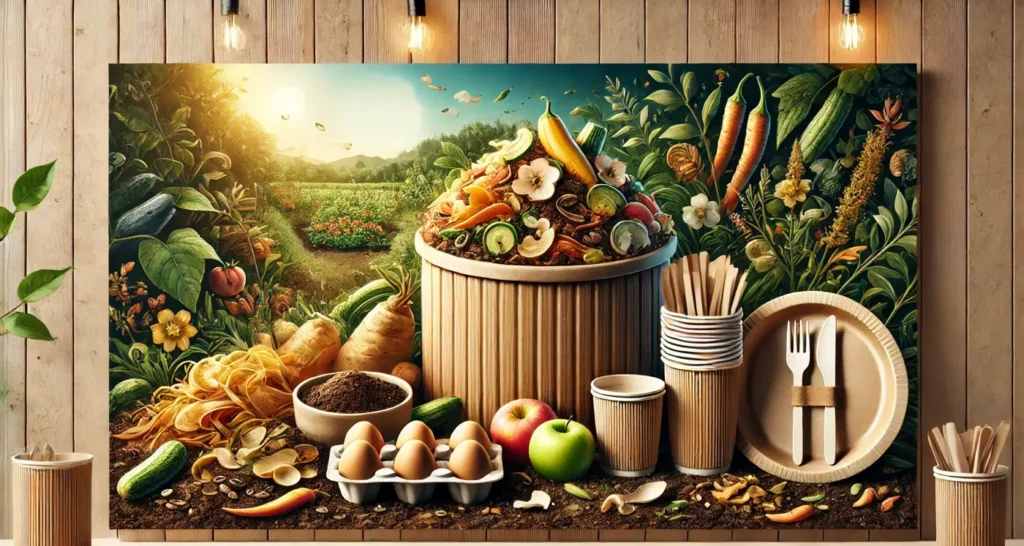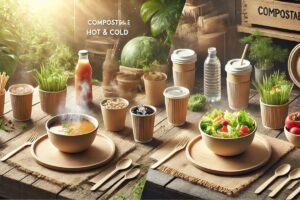
From Kitchen to Compostable Tableware
Why Composting Matters
Each year, millions of tons of organic waste end up in landfills, where they produce harmful methane gas. Composting allows food scraps, yard waste, and compostable products to break down naturally, turning them into nutrient-rich soil instead of waste.
Benefits of Composting
- Reduces landfill waste – Composting diverts organic materials from landfills, helping to lower emissions.
- Improves soil health – Compost enriches soil with nutrients, promoting plant growth and water retention.
- Cuts down on chemical fertilizers – Using compost reduces the need for synthetic fertilizers, which can disrupt soil balance.
Step-by-Step Guide to Composting at Home
Composting is easier than you think! Follow these simple steps to get started:
Step 1: Choose a Composting Method
There are three main composting methods to consider:
- Backyard Composting – Ideal for homes with outdoor space; requires a compost bin or pile.
- Indoor Composting – Perfect for small spaces; often involves using a composting tumbler or worm composting (vermicomposting).
- Municipal/Commercial Composting – Many cities offer composting programs for food scraps and compostable tableware.
Step 2: Know What to Compost
To create nutrient-rich compost, you need the right mix of greens (nitrogen-rich materials) and browns (carbon-rich materials).
Compostable Items:
- Greens: Fruit and vegetable scraps, coffee grounds, eggshells, grass clippings.
- Browns: Dry leaves, shredded newspaper, cardboard, sawdust, compostable paper products.
- Compostable Tableware: Plates, bowls, cups, and utensils made from materials like sugarcane bagasse, cornstarch, bamboo, or PLA.
Avoid Composting:
- Plastic, glass, or metal.
- Dairy, meat, and oily foods (they attract pests).
- Stickers on fruit or non-compostable food packaging.
Step 3: Maintain Your Compost
- Turn your compost regularly to help it decompose faster.
- Keep it moist but not soaked—it should feel like a damp sponge.
- Ensure a balanced mix of greens and browns to prevent odor and pests.
How to Compost Simply Clean’s Compostable Tableware
Switching to compostable tableware is a great way to reduce waste, but proper disposal is key.
- Check for Certification – Look for BPI-certified compostable products, like those offered by Simply Clean, to ensure they break down properly.
- Use Industrial Composting When Possible – Many compostable items, especially PLA cups and utensils, require higher temperatures found in commercial composting facilities.
- Home Composting – Paper-based compostable plates, napkins, and bowls can break down in home compost bins, especially when shredded into smaller pieces.
- Avoid Mixing with Recycling – Compostable materials should never go into the recycling bin, as they contaminate recyclable plastics and paper.
Why Choose Simply Clean for Compostable Tableware?
At Simply Clean, we provide high-quality compostable plates, utensils, and cups designed to break down efficiently in composting environments. Our products help businesses and individuals reduce waste without compromising on convenience.
- Certified Compostable – Our products meet BPI and CMA standards, ensuring proper decomposition.
- Safe & Durable – Free from BPA, PFAS, and harmful chemicals, making them safe for food contact.
- Versatile for Businesses & Homes – Ideal for restaurants, events, and households.
Start Composting Today!
By composting food scraps and switching to compostable tableware, you can make a significant impact on waste reduction. Whether you’re a small business, an event planner, or an individual looking to adopt better waste management habits, composting is a simple step toward a cleaner future.
🔗 Shop Simply Clean’s compostable tableware today!



